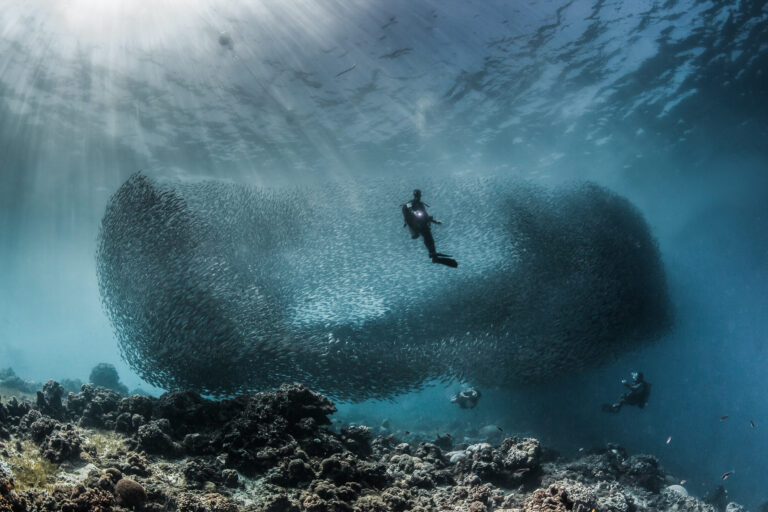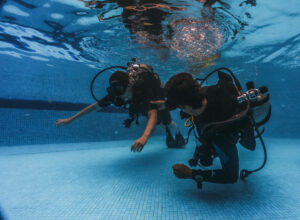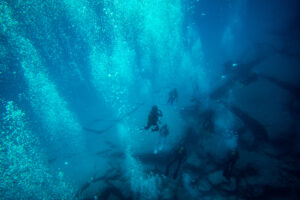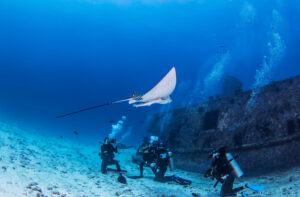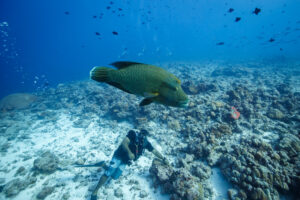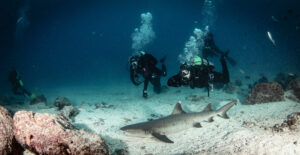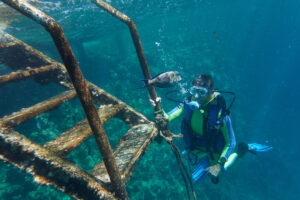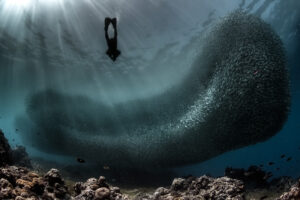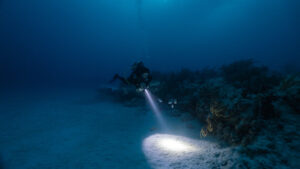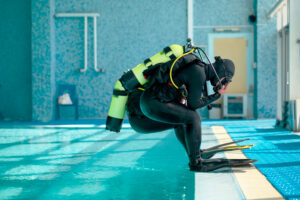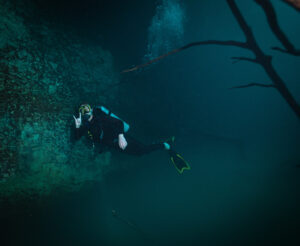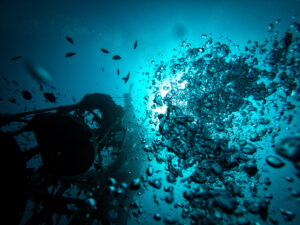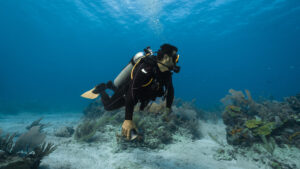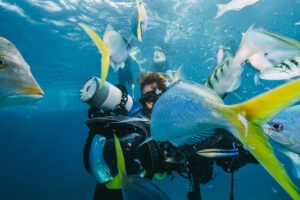What is a Drop Weight?
A drop weight, a fundamental tool in scuba diving, plays a crucial role in managing a diver’s buoyancy. By adding or removing weight, divers can achieve neutral buoyancy, allowing them to maintain a stable position underwater without floating upwards or sinking uncontrollably. This balance is essential for conserving energy, enhancing underwater navigation, and ensuring safety during a dive. Drop weights can be attached to a diver’s belt, integrated into buoyancy control devices (BCDs), or even strapped to ankles, depending on individual preferences and specific diving conditions.
Historical Background
The concept of using weights to control buoyancy in water dates back centuries, long before modern scuba diving equipment was developed. Early divers, including sponge divers and pearl hunters, would carry stones or other heavy objects to help them descend and remain underwater longer. These rudimentary methods laid the groundwork for the development of more sophisticated buoyancy control techniques.
With the advent of recreational scuba diving in the mid-20th century, the need for effective buoyancy control became more pronounced. Early scuba divers often used weight belts made of canvas or webbing, with pockets to hold lead weights. These belts allowed divers to add or remove weights as needed, providing a rudimentary but effective means of achieving neutral buoyancy. Over time, the design and materials of weight systems evolved, leading to the development of more advanced and comfortable options.
The introduction of integrated weight systems in buoyancy control devices (BCDs) marked a significant advancement in diver comfort and safety. These systems allowed divers to distribute weights more evenly across their bodies, reducing strain on the lower back and improving overall buoyancy control. As diving technology continued to progress, manufacturers began experimenting with different materials and designs for drop weights, leading to the diverse range of options available to divers today.
Types of Drop Weights
Drop weights come in various forms, each designed to meet the specific needs and preferences of divers. Belt weights are perhaps the most traditional type, consisting of lead weights threaded onto a belt worn around the waist. These weights are adjustable, allowing divers to add or remove them as needed to achieve the desired buoyancy. Belt weights are popular due to their simplicity and ease of use, making them a staple in many divers’ gear setups.
Integrated weights, found in buoyancy control devices (BCDs), represent a more modern approach to weight management. These weights are housed in specially designed pockets within the BCD, allowing for a more even distribution of weight across the diver’s body. Integrated weights offer several advantages, including improved comfort and streamlined profiles, which can reduce drag and make swimming more efficient. Additionally, many integrated weight systems feature quick-release mechanisms, enabling divers to jettison the weights in an emergency.
Ankle weights are another type of drop weight, used primarily by divers who need additional help maintaining a horizontal position in the water. These weights are strapped around the ankles and can help counteract the buoyancy of the legs, making it easier to achieve and maintain proper trim. Specialty weights, such as trim weights, are designed to fine-tune a diver’s buoyancy and balance further. These weights can be placed in various locations on the diver’s gear, allowing for precise adjustments to achieve optimal buoyancy and trim.
Materials used for drop weights have also evolved, with lead being the most common due to its density and effectiveness. However, concerns about lead’s environmental impact have led to the development of alternative materials, such as coated lead and non-toxic metals. These alternatives aim to provide the same level of performance while reducing the potential for environmental contamination.
Function and Mechanism
Drop weights are essential for controlling a diver’s buoyancy, which is the ability to maintain a stable position in the water without floating to the surface or sinking to the bottom. By adding weight, divers can counteract the natural buoyancy of their bodies and equipment, allowing them to descend and remain at a desired depth. Conversely, removing weight can help a diver ascend or maintain neutral buoyancy at shallower depths.
The process of adjusting buoyancy using drop weights is straightforward but requires careful consideration and practice. Divers must calculate the amount of weight needed based on several factors, including their body weight, the type of wetsuit or drysuit they are wearing, the buoyancy characteristics of their equipment, and the water conditions. Typically, divers perform a buoyancy check at the beginning of a dive to ensure they have the correct amount of weight. This involves floating at the surface with an empty BCD and taking a deep breath; the diver should float at eye level when properly weighted.
Once underwater, drop weights help divers maintain neutral buoyancy, allowing for controlled movements and reducing exertion. Achieving neutral buoyancy is crucial for conserving air and energy, as it minimizes the need for constant adjustments to depth and position. Properly balanced weights also contribute to improved underwater visibility, as divers can hover without disturbing the sediment on the seafloor.
In addition to aiding buoyancy control, drop weights play a vital role in emergency situations. Quick-release mechanisms on weight belts and integrated weight systems allow divers to jettison their weights rapidly if needed. Dropping weights can help a diver ascend quickly in case of an emergency, such as equipment failure or a medical issue. This safety feature is a critical aspect of drop weight design and underscores the importance of proper training in their use.
Safety Considerations
Using drop weights safely is paramount to ensuring a successful and enjoyable diving experience. One of the primary safety considerations is proper weight distribution. Unevenly distributed weights can cause balance issues and make it difficult to maintain a stable position underwater. Divers should take care to distribute weights evenly across their bodies, using trim weights or ankle weights as needed to achieve a balanced configuration.
Another important aspect of safety is the secure attachment of drop weights. Weight belts should be fitted snugly to prevent them from slipping off during a dive. Integrated weights should be properly secured in their pockets, with quick-release mechanisms functioning correctly. Regular maintenance and inspection of weight systems are crucial to identify and address any wear or damage that could compromise their effectiveness.
Accidental weight loss can be a significant safety hazard, leading to uncontrolled ascents that can result in decompression sickness or other injuries. Divers should be aware of the potential for weights to become dislodged and take precautions to minimize this risk. Ensuring that weight belts are fastened securely and checking the condition of weight pockets and attachment points can help prevent accidental loss.
Environmental considerations also play a role in the safe use of drop weights. Divers should be mindful of the impact of lead weights on marine ecosystems. When using lead weights, it is essential to handle them carefully to avoid leaving any residues in the water. Divers can also consider using environmentally friendly alternatives to lead, such as coated weights or weights made from non-toxic materials.
Training and Best Practices
Proper training is essential for the effective use of drop weights in scuba diving. Divers should receive instruction on calculating the appropriate amount of weight for their body and equipment, performing buoyancy checks, and adjusting weights as needed during a dive. Training should also cover the use of quick-release mechanisms and the procedures for dropping weights in an emergency.
One of the best practices for using drop weights is conducting a thorough buoyancy check before each dive. This involves floating at the surface with an empty BCD and taking a deep breath to ensure the diver is correctly weighted. If necessary, divers can add or remove weights to achieve the optimal buoyancy. Conducting buoyancy checks helps prevent issues related to over- or under-weighting, which can affect buoyancy control and overall safety.
Divers should also practice adjusting their weights based on changing conditions and dive profiles. Factors such as water temperature, exposure suit thickness, and the type of dive can influence buoyancy needs. Regularly reassessing and adjusting weights can help divers maintain proper buoyancy control and ensure a comfortable and safe diving experience.
Maintenance of drop weights and weight systems is another critical aspect of best practices. Divers should regularly inspect their weight belts, integrated weight pockets, and quick-release mechanisms for signs of wear or damage. Cleaning and drying weights and weight systems after each dive can help extend their lifespan and maintain their effectiveness. Proper storage, such as keeping weights in a cool, dry place, can also prevent corrosion and deterioration.
Key Takeaways
Drop weights are an essential component of scuba diving, providing critical support for buoyancy control and safety. Understanding the different types of drop weights, their functions, and the mechanisms behind their use is crucial for divers at all levels. Safety considerations, proper training, and best practices are vital to effectively using drop weights, ensuring a balanced, comfortable, and secure diving experience. By mastering the use of drop weights, divers can enhance their underwater performance and safety, making every dive more enjoyable and efficient.

